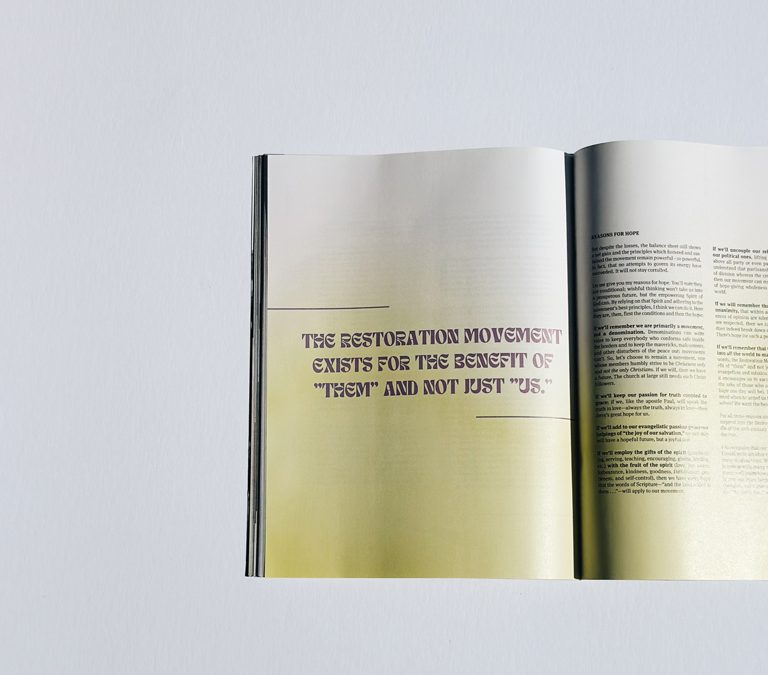By Jim Putman
Though I grew up a preacher’s kid—and maybe because of it—I ended up in college as an unbeliever with a drinking problem. I had rejected my parents, but they were waiting to journey with me back to Jesus. Back then, I would have said there is no God . . . that God had been “educated” out of me. I was no victim, however—I was rebellious.
My father sent me research that affirmed that some scientists believed in God, even though professors had told me no reputable scientist could. Over time, I moved from “there is no God” to “there is a god, but which god?” I was convinced he couldn’t be the Christian God, so my dad sent me a Josh McDowell book to try to change my mind. I was working toward my degree in history (I later graduated to be a teacher), and Dad thought McDowell’s work would fit my research to discover which religion was historically true.
After using historical principles to compare and contrast religions, I came to believe Jesus is the Son of God. Bottom line—I believed the New Testament . . . that the account of Jesus is accurate history and the other religious documents are not.
This did not make me feel better, however, because I still didn’t understand the gospel. That’s when my dad shared the gospel as he understood it. I still had a problem though. I had grown up attending Christian school . . . where there was much disagreement among Christians! In college, I also heard the different brands of Christianity fighting about almost everything.
Consider the variety of beliefs regarding how a person “got saved.” Some Christians contend a person needs only to say a special prayer. Other Christians say baptism in water is required—though they disagree whether sprinkling is adequate or immersion is necessary. Christians also disagree about baby baptism verses adult baptism.
On a personal level, some spoke to my addiction problems by saying that merely accepting Jesus would eliminate it if I had the Holy Spirit, while others recommended a 12-step group.
A lot was riding on this decision, it seemed to me at the time. Hell itself could very well be on the line . . . even though I already believed in Jesus.
More doubt followed. Was the Bible really God’s Word, or was it just a historical account about Jesus? Was part of it God’s Word and part of it not God’s Word? And if the Bible is God’s inspired Word, but we can’t figure out what it means, then who cares? If there was a right way to read it, then what was it, and why weren’t people reading it that way?
A Historical Look at Changes in Beliefs
It was at that point that I went back to my roots and dug into early church history. I decided to use historical principles to determine what the early church believed. Why? Because historians know that the earliest accounts give us the best view into the truth. I had decided on Christianity, in part, because I believed credible witnesses had given us an unchanged story. I accepted that these witnesses had accurately described the events and also had given us the right meaning of those events.
I decided to research what the first Christians believed the Scripture writers meant in their writings. The biblical story had not changed over time, but the interpretations of Scripture sure had.
As a history student, I knew about the changes in Christian beliefs that had occurred through the years—the councils, Constantine, the Great Schism—albeit from a secular perspective. I knew that the Roman Catholic Church had made a practice of changing their beliefs over their history. I also knew about the Reformation and their concept of Sola Scriptura as a reaction to those changes by the Roman Catholics.
The Reformers were rightly concerned about things like the papacy, Mary, indulgences, saved by works rather than grace, and many more cases of historical revisionism. Though sympathetic, I thought they had swung the pendulum too far in the opposite direction. The Reformers relied on the Bible alone, along with the leading of the Holy Spirit, as their only guide for faith and practice. But I felt (and continue to feel) this opened us up to a whole new set of problems. Those problems played out in the many versions of Christianity that sprung up after the Reformation Movement. In fact, it led to the problem I was having—who and what is right?
How can I know or hold to a faith that is always open to change based on new versions of inspired insight? How can I believe something is true when it is open to new scholars who come to new conclusions? If the Bible has been clear on something from the beginning—something that might be deemed a less important issue—and change is allowed, then what might be next? The same approach to changing belief about less important issues will be employed by others on something more important later. A world like this leads people to wonder whether there is objective truth—so they just decide on their own. No unity exists except to say, “You be you, and I’ll be me.” Truly, if we should speak only where the Bible speaks, but we can’t know what it actually means, then how do we speak at all?
Teachings + Interactions + Systems = Understanding
We know that what was recorded in Scripture was not all there was to the story. Much is written about Jesus, but John made it clear that if everything Jesus had said and done were written down, the earth’s books could not contain them. Jesus’ form of disciple-making included teaching in sermons, but also much more. Jesus included modeling what his words meant in practice. He answered questions, clarified, had personal conversations, etc. A personal element went along with the actual teacher-listener interaction. Jesus later sent the Holy Spirit to help his followers, but he still sent the disciples to play a part in the process. Reliable men and women teaching and interacting with others, and so on.
We know the apostles asked Jesus questions of clarification and that these were not written down. Further, we know the apostles also taught people who would ask clarifying questions. Therefore, I could not only read what they wrote, but study how the early Christians put those teachings into practice based on the written and unwritten interactions. In combining the teaching with the interactions and the implementation, we discover what was meant by the teacher.
The apostles understood Jesus had sent them out to make disciples. The message was shared (not changed); the Holy Spirit was the best way to guarantee accurate reproduction. We can’t divorce the teachings of Jesus from the methods of Jesus and expect to get the results of Jesus.
Acts 2:42 tells us the people were devoted to the teachings of the disciples, and this shaped all the behaviors that followed. They took Communion together in a certain way. They prayed in specific ways together. They lived in specific relational environments—and gave in specific ways. They did not just listen to a message from the Scriptures, only to be left alone to figure out what that story or message meant in practice. Questions surely came up, including many of the same questions I was having. The answers they gave then, I think, should be the standard we use for answering those questions today.
You might say that Bible scholarship includes an understanding of interpretation principles to arrive at a correct scriptural meaning. Principles like understanding the context of the passage, using other Scripture to interpret Scripture, understanding the type of literature being read, and a deep dive into the Bible’s original language reveal how we should understand Scripture and apply it in our time. I agree on this to a point. This is helpful to a believer and should be a part of a disciple’s journey.
However, the historical principle often is left out in favor of modern-day interpretations. Why? Because we don’t often know or care what was taught in the beginning. Today’s culture thinks newer is better. The historical principle, at least in part, should include how Scripture was received and implemented at the time it was first given. If an interpretation is new, it probably isn’t true.
There are many examples of modern-day teachers who question long accepted understandings of various Scriptures. This is not new. In the early church, some had unorthodox interpretations, but the overwhelming testimony is that those different interpretations were rooted out. All that to say that the earliest understanding was the one held to and used for a defense against anything that challenged “the faith” once for all delivered. I believe the same God who protected the process of creating the canon also protected the early churches’ view of the most important beliefs. While the early church didn’t agree on everything, these historical principles lead us closest to what was and is right.
Here Comes the Restoration Movement
My personal journey with history led me to the Restoration Movement for reasons that should be clear by now. When I discovered a movement that sought not to reform the church but to restore it, it appealed to me greatly. To a history person, it just makes sense. It answered my many questions.
The New Testament writers were inspired, but I believe the disciples of those disciples were not inspired. (However, I also believe the early church had the best chance of understanding what the inspired writers meant.) This means, of course, that I am not inspired. Nor were the Reformers; nor were Barton Stone or Thomas and Alexander Campbell.
In my view, the Restoration Movement principles best reflect the New Testament’s warning to “contend for the faith that was once for all [past tense] entrusted to God’s holy people” (Jude 3).
For many years, I have felt I had a home in the Restoration Movement. Why? Because I believed the movement itself represented a Josiah moment in time. As told in 2 Kings and 2 Chronicles, Josiah came to power at a time when the faith had been corrupted, but he did not know to what extent. The nation was just living out what had passed down to them over time. But then, at Josiah’s direction, his subjects began to clean out the temple and found the book of the Law. When it was read to Josiah, and the king compared it to how they had actually been living, he was broken. He rejected the changes that had been made over time, and he began to move back to the Scriptures and what they had commanded.
I felt at home with the Restoration Movement because this was its heart from the beginning.
As I look at the Restoration Movement today, I think many have forgotten what it was really about. In the November/December issue I will tell you why.
Jim Putman serves as senior pastor of Real Life Ministries in Post Falls, Idaho. He holds degrees from Boise State University and Boise Bible College and is the author or coauthor of various discipleship books, including Church Is a Team Sport, Real-Life Discipleship, and DiscipleShift.





Excellent! I agree wholeheartedly and I look forward to the next part of the series. Also look forward to perhaps some of the best resources available to substantiate your interpretations of the historical concepts mentioned.
Great article, Jim. I came out of denominationalism and love the New Testament church. I was taught about the restoration movement, and it answered my souls’ questions like it did you. You do not hear about it much in our churches today, and when I preach on it so many people are appreciative that I did. Looking forward to your articles.
I am looking forward to the next issue. It sounds like brother Putnam is working along Alexander Campbell’s own lines. Campbell’s life was dedicated to a continuous examination of scripture and it’s teaching.
The problem with the concept of a restoration modeled on the Early Jerusalem Church is fundamental. Should we all become Messianic Jews? It does not take much, even casual reading of Acts to understand that Peter was a practicing Jew before the Resurrection and he was a practicing Jew (fulfilled) after the Resurrection. The early church worshiped at the Temple. They observed Jewish religious culture. In fact, the Jerusalem leadership (James and others) was so determined to remain true to the faith, they felt that Paul’s rejection of Jewish practices when it came to the beliefs of the Gentile Church was dangerous to the faith. He was warned on more than one occasion to remain faithful. There were some compromises given to the Gentiles, but even at Paul’s final visit to Jerusalem, he was again forced to stop telling church members of Jewish background that they could abandon their Jewish religious practices (Acts 21). Only with the fall of Jerusalem and the destruction of the Temple did the Church break away from its strong Jewish beginnings. So which model of the early church do you accept, the original Jewish Jerusalem Church or Paul’s later Gentile Church? By the way, if there were thousands of Christians in Jerusalem at the time of Paul’s arrest, why is there no mention of anyone, including the Church elders supporting him during his Roman arraignment?
Well Mr Edmonds you apparently have extra biblical sources from what my understanding of your comments .
Also Acts 21:21 seems to me you are misinterpreting one verse and ignoring the others.
Great piece. I heartily encourage more in this area as I see critical needs in my own observations and study. I see, or read, of declines in musical participation, Bible college attendance, Bible college closings, declines in assembly attendance, operation of familiarity blindness and more.
(For perspective, I’ve been a member/leader in about 10 congregations and a church consultant in 3 states).
Praise the Lord! Great words. After over 50 years of ministry my wife and I finally took the time last month to drive several hundred miles to visit the Cane Ridge Meeting House down near Paris, KY, I spent a couple of hours just strolling around the grounds, visiting the church house and the museum and imagining what that revival must have been like with the thousands who were there.
I too was a history major in a large public University but, by God’s grace I happened to move into a house with 15 guys who were Christians – like no Christians I had ever seen or known. And that University had a campus minister who not only knew Scripture, he knew the history of the church and – especially – Apologetics, Evidences, Textual Criticism, Hermeneutics, as well as the value of taking an historical approach to understanding and trusting God’s word – and living it day by day (Roy Weece). He could answer the many questions I had and the many untruths that I had come to believe.
During that time I was in college, the US experienced probably the greatest revival that it had experienced since the time of Cane Ridge and the Second Great awakening. Barton Stone, Alexander and Thomas Campbell, John Smith, Walter Scott, and many others began to break away from traditional denominations that had migrated here from Europe – and their desire to just be “Christians only” produced a whole new way of thinking about the church.
It has taken a long time, but today there are more churches that are not denominational than there are in denominations … and more Christian leaders who are seeking to restore the historical church we see in Scripture. Unfortunately, I think that many in the Restoration Movement begun in 1801 have become less restorationist in their thinking and theology while many of those who have recently come out of denominationalism are much more passionate in following what we have called, “the restoration plea.” I’m looking forward to hearing what more brother Putman has to say, because I think we are on the brink of another Restoration Movement bringing us to focus on Jesus and His truth.
One of the men in our church family is a professor of church history at a well-known Evangelical seminary close to our church building and he has a great interest and respect for our movement’s history. As we prepared to drive down to KY I spent some time re-reading some of those historical records and that helped me see and appreciate even more the value of our heritage and the role in which God has used our movement to shape His church of today – and hopefully, tomorrow.